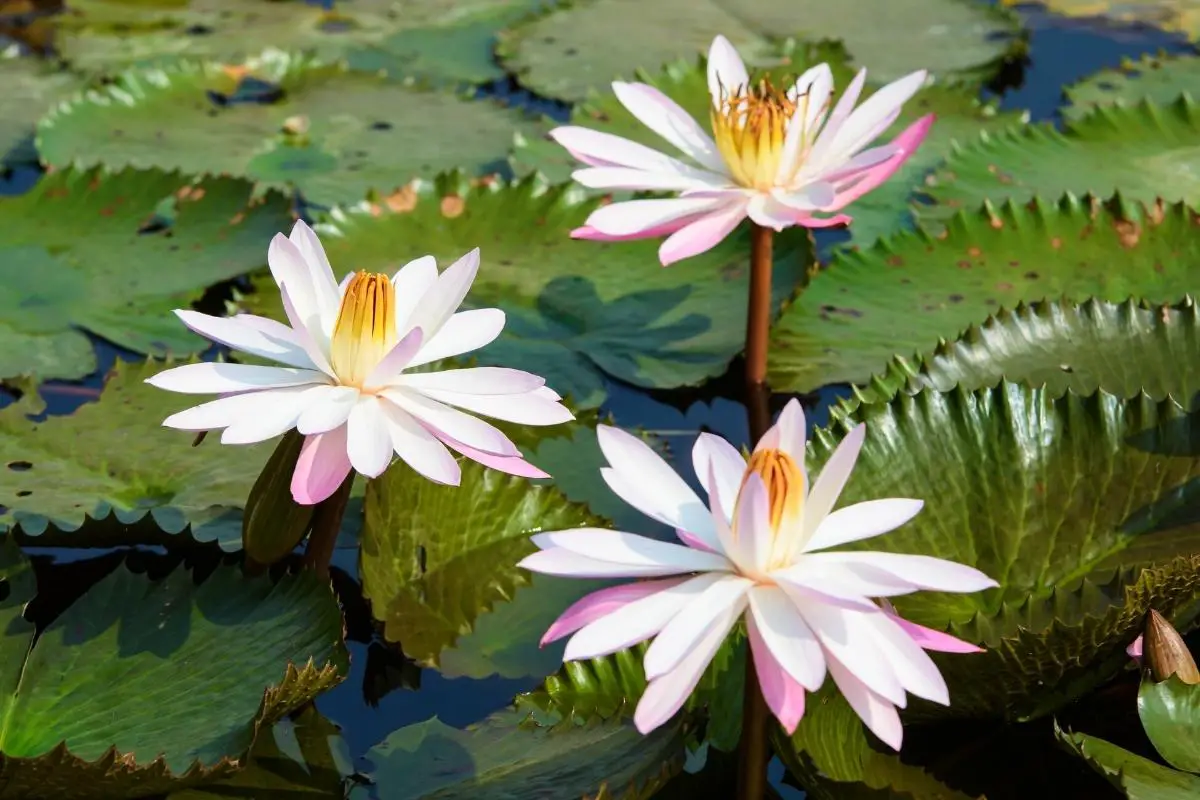Nelumbo nucifera is the scientific name for a perennial flower also known as an ‘Indian lotus’. Many unique things can be learned about the lotus flower, especially since it is considered to be an aquatic plant. The lotus belongs to the Nelumbonaceae family and has an interesting background of symbolism.
Table of Contents
Lotus Flowers
Lotus plants are commonly found across many different types of regions. The most common region would most likely be an area with a small river or flood plain. It natively grows across regions of central India, but can be found in other regions like Eastern Asia and even Australia.
Since the seeds from this plant are extremely tenacious, it has earned the reputation for having exceptional resilience. For general prosperity, lotus plants should receive between five and eight hours of sunlight per day.
They generally can be seen from a long distance since they commonly grow up to seven feet in height. They are generally a few feet wide and have a vibrant pink, purple, and white color tint. This combination of factors makes these flowers easy to find, especially when you are looking in their native growing areas, near small rivers or flood plains.
When Does Lotus Bloom?
Lotus commonly blooms during the middle of the summer. These unique flowers are known as ‘water plants’, but can also survive exceptionally well in pots or containers. Since they have a relatively large range between their height and width, it can be difficult to estimate their total size when they do bloom. If they do receive at least five to six hours of sunlight per day, they should bloom effectively, right in the middle of the summertime.
What Do Lotus Flowers Look Like?
The green foliage on the lotus is paired with vibrant pink and white colors on the tips of the flower. This combination gives an iconic and symbolic look to the lotus plant, which can vary significantly in overall height.
Since lotus is a water plant, these flowers could be an excellent addition to a small water garden. In terms of visual appearance, it can be very attractive to have a bunch of these included within a small water garden.
Two variations of the lotus commonly have flowers that are tinted white, rather than pink or purple. These variations are known as the ‘Sacred Lotus’ and the ‘Baby Doll Lotus’. These two variations can grow to be a bit wider than expected and generally only have slight tints of pink on the tips of their flowers. Almost all other relatively well-known variations like the ‘Double Rose Lotus’ have vibrant pink color patterns that immediately catch the human eye.
Are Lotus Flowers Poisonous?
Lotus plants are not generally considered to be poisonous. Minor side effects can occur for some people when coming into contact with this small water plant. Many parts of the plant are edible. Only a small number of people have reported dangerous side effects or moderate discomfort. Some water lily plants like the lotus can be poisonous, and some variations of this plant may cause more harm than others.
On the opposite side, some lotus flowers, such as the blue lotus, have medicinal properties that help with sleep and anxiety. Its extracts have even been called a mild stimulant. Blue lotus incense is my personal favorite aroma of incense.
Best Temperature For Lotus Plants
Warm temperatures will benefit the lotus plant in the summertime so that they can bloom in time for the autumn. This generally includes temperatures above 70 degrees Fahrenheit, over a few months. They may struggle to bloom if they do not exist in the appropriate temperatures. There can also be problems if they don’t have enough sunlight throughout the day.
Since the lotus flower is actually considered to be an aquatic plant, there can be some additional challenges in the process of getting them to bloom effectively. The right location needs to be balanced with reasonable soil conditions and enough sunlight to be effective.
They are fairly resilient plants and can tolerate dry conditions if they have had enough time to establish and prepare. Despite being a fall perennial plant and a member of the Nelumbonaceae family, they are still capable of surviving in even some of the harshest environmental conditions.
See our article for Fall Flowers here.
Symbolic Meaning of the Lotus Flower
There’s more to the lotus plant than you might think. In addition to all of the factors that play into their growth and blooming process, they also have a lengthy history of symbolism.
Many groups of people reflect on the lotus plant as a flower that symbolizes purity and enlightenment. Other cultures prefer to perceive the symbolism as a sign of rebirth. The characteristics of the flower are a symbol of emotions and strength in some cases, especially for its native cultures. Source.
“As the lotus rises on its stalk unsoiled by the mud and water, so the wise one speaks of peace and is unstained by the opinions of the world.”
– Buddha
Related Questions
Can lotus tolerate shade and still thrive?
While they can certainly grow in moderate or even severe shade, they will always perform their best in full sunlight with warm temperatures. Warmer climates may allow lotus to experience more shade without the negative effects on their growth potential. They should always experience at least a couple of months above an average daily temperature of 70 degrees Fahrenheit, for the best overall growth when it comes time to bloom.
Are lotus flowers exclusively pink and white?
While it is true that lotus flowers are almost always patterned with pink and white colors, they can come in other colors as well. Other common colors include red, blue, yellow, and even purple. Dryer variations of the flower may seem darkened or turn a brownish-yellow tint in some situations as well.

